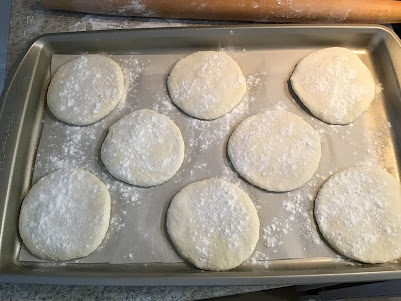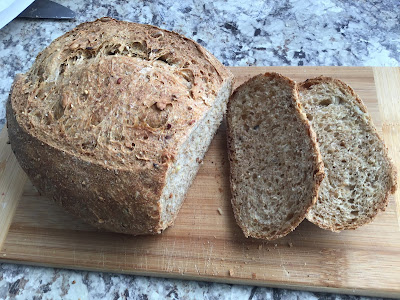After the hard drive on my iMac died last year, I realized that the best place to park information is in a blog and that's why I'm putting this recipe here.
It's one of my most valuable recipes ever because in spite of my striving to eat heathy food most of the time -- my daily bread is in fact
this Danish Rye that I'm crazy about - there are times when I simply must have white bread. A typical example would be a ham and cheese sandwich, of which I am very fond. A grilled cheese sandwich. Something to dip into the gravy, breadcrumbs...
It has taken me at least a year to develop the final version of this recipe and if you are reading this you will notice that I have spared you the different stages. It all started with Craig Ponsford recipe in Maggie Glezer's book
Artisan Baking. Then I tried Leite's Culinaria recipe that I found on the Web. Also the one from The Fresh Loaf, The Perfect Loaf, The Kitchn, three King Arthur Flour ciabatta recipes, and a few others.
The last one I tried was the one for
Ciabatta Rolls on the King Arthur Flour website. I was intrigued by the lesser quantity of water, as compared to all the other recipes. How can you make ciabatta with only 70% hydration, when all the other recipes called for at least 80%, and up to 84%, I asked myself.
I made the recipe exactly as it appeared, including the dimpling and it was not what I was after. Maybe you like your ciabatta flat, but while living in Montreal over the past year I got hooked on the ciabatta rolls from my neighbourhood Italian bakery. They were ugly, they were bumpy, but they were not flat. They had big holes and little holes and a texture not so much creamy as fluffy, almost cloud-like... add a thin crisp crust and a deep flavour and you've got perfection. They made the best ham and cheese sandwiches. They were what I was after.
I mention the thin crust because you might ask yourself why I don't just make baguette if I want French bread. The reason is that for sandwiches, I have never been able to make a baguette (or a French roll) with a crust that didn't tear the inside of my mouth. And now I don't even have to try.
For my final trials, I decided to keep my variables to a minimum, and after adhering strictly to the King Arthur recipe ingredients as my base, and varying the methods, I came to the following infallible recipe, and here it is.
CIABATTA BREAD OR ROLLS
Based on King Arthur Flour Ciabatta Rolls Recipe
YIELD: 10 to 15 rolls, depending on size
Scroll down page for photos
This is the final version as developed by myself based on the KAF recipe and a combination of methods from other recipes and past experience.
This makes a satisfying baguette substitute because the thin crust is suitable for sandwiches, whereas I was never able to make a baguette that worked as well for that. The long fermentation of the starter ensures a good flavour.
Apart from the crust, the main difference is the dough is too wet to shape but dry enough to handle, which is not usually true of ciabatta recipes with higher hydration rates. (This one is about 70%.)
STARTER
175 g unbleached AP flour
225 g cool water
1/16 tsp instant yeast
Mix by hand or in mixer bowl until well combined. Cover and rest at room temperature overnight, or up to 15 hours or more. (I usually leave it about 24 hours, with a few hours in the turned-off oven with the light on to get it started. Then I leave it in the oven with the light off until next day.)
DOUGH
All the starter
150 g lukewarm water
3 TB olive oil
360 g unbleached AP flour
2 tsp instant yeast
2 TB nonfat dry milk
2 tsp salt (adjusted from 2-1/4 tsp originally)
MIX the liquid ingredients in the mixer bowl
MIX the dry ingredients separately in a bowl and stir with a wisk to disperse everything evenly
ATTACH the bowl to the mixer, attach the paddle and mix the liquid ingredients together.
ADD the dry ingredients while running at slow speed, then increase speed to medium (2.5 I think).
MIX for seven minutes. The dough will wrap itself around the paddle and stay there. I usually stop the mixer twice to scrape it down.
FIRST RISE AND TWO FOLDS
OIL a wide container (I use a medium size plastic tub) and pour the dough into it. Cover well with plastic.
SET timer for 60 minutes.
AFTER sixty minutes, give the dough a complete fold with wet hands. This is the technique I use:
SET the timer for 30 minutes.
GIVE the dough a second fold.
SET the timer for 30 minutes.
AFTER 30 minutes, turn oven on at 425 degrees - with my new oven I have found 450 to promote better rise and colour, you could try both.
PLACE pizza stone on middle shelf and steam tray on lower shelf.
SET the timer for 30 minutes.
PREPARE a couche with flour on the strips where the rolls will rest.
IF dough is ready - nice and puffy with big bubbles, turn it onto a very well floured surface and flour the top (which used to be the bottom). Without deflating it too much, form it into a rough square.
DIVIDE the dough into rolls or loaves (I do a combination), using a sharp dough scraper. Place on couche, sprinkle with flour and cover the couche -- I use two upturned disposable turkey pans and white plastic bags. (You could use a scale or a ruler to make them even, but the beauty of ciabatta is in its imperfection.)
SET the timer for 30 minutes.
PREPARE a cup of water and a spray bottle.
PREPARE two peels with parchment and cornmeal.
AFTER the 30 minutes if the loaves or rolls are nice and puffy, transfer some to one of the peels - I use a hamburger lifter for this.
It doesn't matter if you turn them upside-down - if you do they will have flour and wrinkles on top and if you don't they will have a nice smooth top. But do not POKE them even though several recipes say so!
TRANSFER rolls and parchment to stone, pour a cup of water in the steam tray.
BAKE for 15 minutes, spraying with water twice at the beginning
MOVE the front ones to the back and vice versa and finish baking for about 10 minutes - until the right colour. Check internal temperature of the dough to be sure (minimum 200 degrees F).
BAKE the rest of the rolls or loaves similarly.
LET cool before eating!!!
The crust will soften somewhat as it cools.
FREEZE as soon as cool enough. This is actually the best thing to do with this bread because the crust will actually improve after reheating.
REHEAT by placing the bread - frozen or not -in a cold oven and turning it to 400. Set timer for 8 to 10 minutes and you will find the crust has become even crisper but not hard. Let cool. Ideal for sandwiches. That is also why the bread may seem a bit pale after baking - reheating will deepen the colour.
TOASTING. I am relieved that with this recipe - is it the oil or the milk powder or both? - toasting is less problematic. Other ciabattas I tried - being all flour and water have tended to emerge from the toaster hard as a stone.
---------------------------------
My typical schedule goes like this:
FRIDAY
10 AM: Mix starter
SATURDAY
9.15 AM: Finish assembling dough
9.30 AM: First rise
10.30 AM: First fold
11.00 AM: Second fold
11.30 AM: Turn oven on
11.45 AM to 12.00 PM: Divide dough; set timer fir 30 minutes
12.15 to 12.30 PM: Bake first batch
1.00 PM or so: Bake second batch
2.00 PM: Eat!
-------------------------------------
 |
| Dough after two turns, ready for next step. |
 |
| Ready for dividing, note large amount of flour. |
 |
| Couche ready with lots of flour. |

























